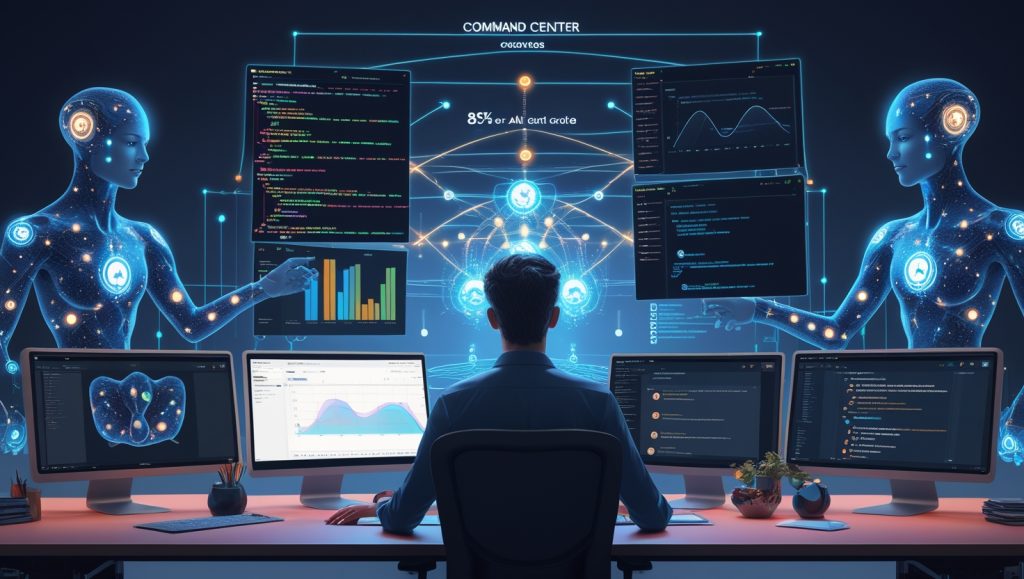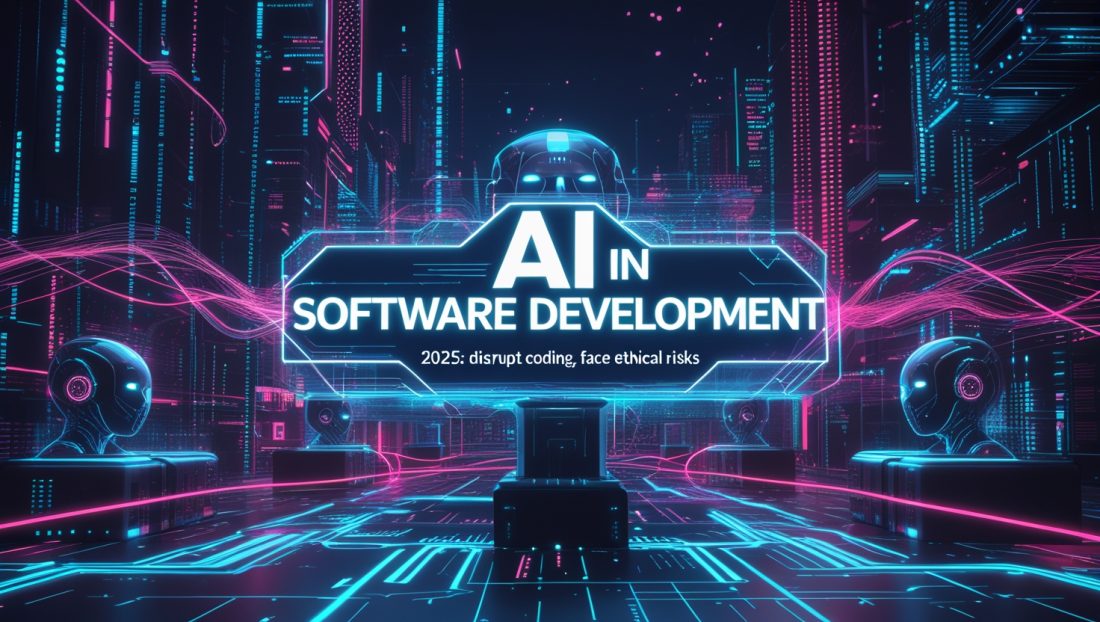The Developer’s Crossroads
Can software engineers thrive when AI writes 35% of new code? This question haunts developers facing GitHub’s revelation about Copilot’s output at Microsoft. The year 2025 marks not the replacement of developers, but the emergence of a new paradigm where AI becomes the indispensable collaborator.
The transformation extends beyond code generation into architecture design, security validation, and system optimization. Organizations report 30-50% faster development cycles, yet junior roles have contracted by 33% as AI handles foundational tasks. This paradox defines our era: unprecedented productivity gains alongside tectonic skill shifts.
1 The AI-Augmented Workflow: Beyond Automation

The Orchestration Imperative
Developers no longer merely write code—they conduct symphonies of specialized AI tools. The modern workflow integrates:
- Context-aware coding assistants like GitHub Copilot that understand entire codebases
- Autonomous testing agents generating 85% of test coverage (versus 40% in 2023)
- Self-healing CI/CD pipelines that predict failures before deployment
Sai Chiligireddy, Amazon Alexa Engineering Lead, noted that developers now spend 70% less time debugging syntax and 50% more time on problem decomposition—the actual engineering work. This shift is evident in tools like those explored in AI-driven model optimization strategies, which highlight how AI streamlines complex workflows for businesses.
Real-World Transformation: Klarna’s Agentic Revolution
When Klarna deployed AI customer service agents, they resolved 85% of tier-1 inquiries autonomously. The system processes payments, handles returns, and negotiates solutions—all without human intervention. This mirrors software development’s shift: AI handles execution while humans focus on exception management and strategic oversight. Similar agentic systems are reshaping industries, as seen in agentic AI in supply chain management, where autonomous decision-making optimizes logistics.
2 Tools Redefining Development
The Reasoning Revolution
AI systems now emulate human problem-solving through chain-of-thought techniques. OpenAI’s o1 model breaks complex coding challenges into logical substeps, enabling:
- Biomedical simulations 100x faster via protein folding analysis
- Legal contract comparison with 98% accuracy
- Multistep workflow automation in DevOps pipelines
This reasoning leap is critical for developers working on AI-driven scientific discovery, where AI accelerates breakthroughs in fields like medicine and physics.
Security Integration
Vulnerability remediation enters a new era with tools like Qodo Merge PR-Agent. These systems:
- Detect zero-day threats through behavioral pattern analysis
- Auto-generate patched code within pull requests
- Reduce critical vulnerabilities by 40% according to GitLab’s 2025 security report
Why AI-Powered Cybersecurity Tools Are Essential for 2025 Development
As cyberthreats evolve, developers must integrate AI-driven security tools to stay ahead. Semantic keyword: AI-powered cybersecurity solutions for developers. These tools analyze code in real time, identifying vulnerabilities before they reach production. For instance, platforms like Snyk leverage AI to scan dependencies, reducing exploit risks by 45%, according to a 2025 cybersecurity report by Snyk. This is particularly vital for developers working on AI-driven cybersecurity threat detection, ensuring robust protection in an era of increasing digital threats.
3 The Skills Reformation
The Rise of AI Whispering
Traditional coding competency gives way to prompt engineering, validation rigor, and AI behavior curation. Developer value now derives from:
- Domain specialization: Healthcare developers who understand HIPAA constraints outperform generic coders
- Ethical auditing: Implementing frameworks like Microsoft’s Responsible AI Standard
- Toolchain integration: Connecting Copilot with testing agents and deployment bots
This shift aligns with AI ethics frameworks, which emphasize responsible AI deployment in development workflows.
The Junior Developer Dilemma
Entry-level positions contracted 33% as AI automates boilerplate tasks. Innovative responses include:
- AI Supervisor Roles: Juniors validate AI outputs while studying system patterns
- Domain-First Apprenticeships: Healthcare and finance pathways bypassing generic coding
- Open Source Contribution: Building portfolios through non-automatable work
Charlie Clark, Liinks Founder, warned that the erosion of foundational skills threatens innovation. New engineers must deeply understand what AI automates—otherwise, they deploy flawed solutions. This challenge is echoed in STEM robotics competitions, which foster hands-on skills to counter automation’s impact.
Why Junior Developers Must Adapt to AI-Driven Roles
The contraction of junior roles demands a pivot to AI-augmented developer skills. New engineers can thrive by mastering tools like DeepSeek-R1, which supports cost-efficient automation, as noted in DeepSeek’s source code release. Platforms like freeCodeCamp offer tutorials on prompt engineering, helping juniors build portfolios in non-automatable domains like ethical AI auditing.
4 Business Impact and ROI
Quantifying the Unquantifiable
While 58% of organizations claim exponential productivity gains, rigorous measurement remains elusive. Goldman Sachs stands out by documenting:
- 20% developer productivity increase via AI pair programming
- $18 million annual savings in testing automation
- 30% faster time-to-market for customer-facing applications
This aligns with AI-powered regtech advancements, where measurable ROI drives adoption in regulated industries.
4 Legacy Modernization Breakthrough
Generative AI finally makes legacy transformation viable. Tools now:
- Auto-refactor COBOL to Java at 90% accuracy
- Generate migration documentation from source code
- Reduce modernization costs by 60% according to Morgan Stanley’s 2025 TMT report
Why Legacy Modernization Is a Game-Changer for Enterprises
The ability to modernize legacy systems with AI-driven legacy code transformation is unlocking billions in savings. Tools like IBM’s Watson Code Assistant streamline COBOL-to-Java conversions, cutting migration time by 50%, per a 2025 IBM report. This complements efforts in robotic microfactories for on-demand manufacturing, where AI-driven automation reshapes enterprise efficiency.
5 Emerging Frontiers
Edge-Native Development
Latency-sensitive applications embrace local AI processing:
- Smart factories using on-device quality control vision systems
- Medical devices diagnosing conditions offline via embedded models
- Privacy-first applications keeping sensitive data on-user-device
This trend is critical for edge AI powering real-time intelligence, enabling faster, secure processing.
Custom Silicon Ascendancy
Specialized chips transform AI efficiency:
- Azure Maia AI accelerators cut training costs by 40%
- Google TPU v6 delivers 4x throughput for inference workloads
- Water-cooled data centers reduce environmental impact by 30%
Why Custom Silicon Is Redefining AI Development
The rise of custom AI chipsets for developers is slashing costs and boosting performance. Companies like NVIDIA are leading with solutions like DGX systems, as seen in NVIDIA DGX personal AI computers, which empower developers to train models locally. A 2025 NVIDIA report highlights a 35% reduction in energy costs for AI workloads, aligning with sustainable development goals.
6 Ethical Imperatives
Regulatory Landscapes
The EU AI Act (2025) mandates:
- Disclosure of AI-generated code percentages in critical systems
- Auditable decision logs for autonomous agents
- Bias testing across demographic dimensions
These regulations shape global AI regulation divides, influencing how developers navigate compliance.
Security in the Agentic Age
New vulnerabilities demand novel defenses:
- Adversarial prompt injections manipulating model outputs
- AI supply chain poisoning through compromised training data
- Multi-agent review systems providing cross-validation
7 Workforce Transformation
Geographic Redistribution
Tech hubs fragment as talent disperses:
- 42.98% developers now work fully remotely
- Emerging hotspots in South Dakota (+17%) and Hawaii (+32%)
- Global outsourcing to India growing at 7.25% CAGR
This shift supports AI-curated communities, fostering global collaboration.
High-Value Roles Emerge
Compensation premiums favor:
- AI Security Auditors ensuring compliance
- Domain-Specific Prompt Engineers
- Edge Computing Specialists
- Technical AI Trainers
- Ethical Compliance Officers
Strategic Adaptation Framework
- Master the Toolchain: Integrate Copilot (generation), Qodo (testing), and Claude (review) into unified workflows
- Develop T-Shaped Expertise: Combine vertical domain knowledge with horizontal AI orchestration skills
- Contribute to Open-Source AI: Build visibility through non-automatable work in projects like DeepSeek-R1
- Specialize in Impact Domains: Healthcare, climate tech, and cybersecurity offer AI-resistant opportunities
- Become an AI Translator: Bridge technical teams and business stakeholders on capabilities and risks
The Creative Renaissance
AI software development in 2025 liberates engineers from mechanistic tasks, elevating the craft to its highest potential. The transformation echoes through Klarna’s automated resolutions, Goldman Sachs’ measured productivity, and Microsoft’s responsible frameworks. Developers who embrace this partnership will design systems previously unimaginable—from climate modeling simulations to personalized medicine platforms, as seen in AI for social rewilding.
The future belongs not to those who code longest, but to those who think deepest. As Satya Nadella observed, we’re not replacing developers; we’re freeing them to solve harder, more meaningful problems. This is software engineering’s second renaissance—where human creativity, amplified by artificial intelligence, redefines what’s possible.
FAQ: Critical Questions Answered
Will AI replace software developers by 2040?
Oak Ridge National Laboratory’s prediction of AI “writing most code by 2040” reflects automation of tasks, not roles. Developers will transition to higher-value architecture, domain-specific design, and AI oversight.
How are companies measuring AI’s ROI?
Leading firms use controlled experiments: comparing AI-assisted vs. traditional teams on metrics like defect rates, deployment frequency, and feature delivery speed. Goldman Sachs documented 20% productivity gains through rigorous measurement.
What skills offer the strongest career protection?
Domain expertise (healthcare/finance), prompt engineering, AI security auditing, and legacy system modernization show the lowest automation risk and highest compensation premiums.
How significant are data privacy concerns?
Critical. Edge computing adoption grows 78% annually as applications process sensitive data locally. The EU AI Act imposes strict transparency requirements for AI-generated code in regulated systems.
Are low-code platforms replacing developers?
They’re transforming roles. Professional developers now design reusable components for citizen developers, integrate systems, and ensure enterprise-grade security—shifting from writing boilerplate to architectural oversight.
